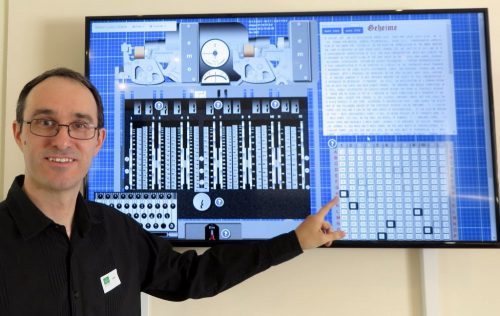Virtual Lorenz revealed in tribute to Bill Tutte and wartime codebreakers
 A Virtual Lorenz that can be used by anyone wanting to experience sending and receiving top secret Second World War communications was unveiled at The National Museum of Computing in celebration of the centenary of Bill Tutte, the man who unravelled the secrets of Hitler’s most secret encryption device.
A Virtual Lorenz that can be used by anyone wanting to experience sending and receiving top secret Second World War communications was unveiled at The National Museum of Computing in celebration of the centenary of Bill Tutte, the man who unravelled the secrets of Hitler’s most secret encryption device.
Thought to be unbreakable, Lorenz encryption was used in the top-secret teletype communications of the German High Command during the Second World War. But the ingenious work of Bill Tutte at Bletchley Park unravelled the mysteries of the highly complex twelve-rotor Lorenz SZ42 machine even though he never saw the device until after the war. Tutte’s work, often regarded as the greatest intellectual feat of the war, shortened the conflict by enabling the decryption of the enemy’s strategic messages on a regular basis – and very rapidly with the help of Colossus computers.
At the Bill Tutte centenary event, Martin Gillow unveiled his creation of a Virtual Lorenz that runs on the web and can be used by anyone with internet access. Looking, operating and even sounding uncannily like a real Lorenz SZ42, virtual start wheels appear in 3D and whirr and as they are set, teletype chattering noises are heard as communications are exchanged and the encrypted and unencrypted text appears on screen as messages are sent and received. Even the Ablesetafel used to establish the start wheel settings is represented. In practice, the Virtual Lorenz is easier to use than its wartime real-time equivalent.
 Martin Gillow explained the inspiration of the Virtual Lorenz. “As a programmer, I was fascinated by the rebuild of Colossus computer when I first saw it at The National Museum of Computing. Tony Sale, who led the rebuild team, had also created a Virtual Colossus for the web, but I discovered that it would only run on old browsers. Since Tony Sale had passed on, it was likely to become inaccessible and lost forever as web technologies progress.
Martin Gillow explained the inspiration of the Virtual Lorenz. “As a programmer, I was fascinated by the rebuild of Colossus computer when I first saw it at The National Museum of Computing. Tony Sale, who led the rebuild team, had also created a Virtual Colossus for the web, but I discovered that it would only run on old browsers. Since Tony Sale had passed on, it was likely to become inaccessible and lost forever as web technologies progress.
“So, I decided to recreate the Virtual Colossus – and then a Virtual Lorenz to accompany it. It took months of work in my spare time, and revealing it to the audience at the Museum was a real thrill.”
At the event, Lorenz-encrypted messages were sent between Block H, the home of Colossus and TNMOC on Bletchley Park, and Ben Trethowan, a TNMOC volunteer and modern day cyber security expert near Guildford in Hampshire. True to the wartime history, two messages were sent – with the same wheel settings, but the second with abbreviations – that was the operator mistake that led to the first breakthrough in uncovering the secrets of Lorenz encryption.
The Virtual Lorenz is available for anyone to use at lorenz.virtualcolossus.co.uk
An original Lorenz SZ42, an Ablesetafel that determined the wheel settings and a German military teleprinter are on display in the Tunny and Colossus Galleries at the The National Museum of Computing – alongside reconstructions of the full set of equipment used by the Bletchley Park codebreakers to decrypt the messages sent by German High Command. The Colossus and Tunny galleries are open daily 10.30am – 5pm.








